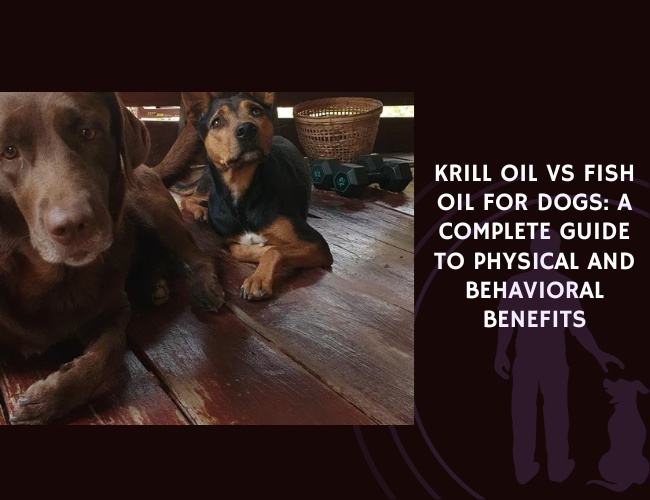Introduction: Understanding Omega-3 Supplements for Dogs
Why Omega-3s Matter for Dogs
Omega-3 fatty acids play a key role in your dog’s health, from supporting brain function to promoting a shiny coat and easing inflammation. Many dogs do not get enough omega-3s just from their regular food, especially if their diet is heavy on processed kibble or cooked meat. That’s why supplements can make a real difference to your dog’s wellbeing.
The Choices: Krill Oil and Fish Oil
When you start shopping for omega-3 supplements, two main options stand out: krill oil and fish oil. Both are rich sources of the omega-3 fatty acids Eicosapentaenoic Acid (EPA) and Docosahexaenoic Acid (DHA), but they come from different marine sources. Fish oil comes from fatty fish like salmon or sardines. Krill oil is made from tiny shrimp-like creatures called krill. Each oil has a unique structure and nutrient profile, which can affect how well your dog absorbs and benefits from the supplement.
Empowering Owners with Knowledge
It can be confusing to sort through different supplement claims and pick the right product for your furry friend. This guide is here to help you better understand the physical and behavioral benefits of both krill oil and fish oil, so you can make a choice based on science and your dog’s unique needs. Making informed decisions means your dog gets the support they deserve! 😊
With a clear understanding of omega-3 supplementation’s importance, it’s now time to explore the science of how these nutrients work in your dog’s body.
The Science Behind Omega-3 Fatty Acids
What Are EPA and DHA?
Eicosapentaenoic acid (EPA) and docosahexaenoic acid (DHA) are the star players in the omega-3 fatty acid group. Dogs cannot make these essential nutrients in their bodies, so they rely on their food—or supplements—for supply. EPA and DHA are crucial for many body processes, from brain development to managing inflammation. If your dog’s diet lacks these nutrients, key body functions might not work as well as they should.
How Omega-3s Work in Dogs
Omega-3 fatty acids support every cell in your dog’s body. Their job starts in the cell membrane, where they help keep cells flexible and healthy. This means messages and nutrients move smoothly in and out of the cells. Because cells are the building blocks of all tissues—and health starts on this tiny level—omega-3s are vital for heart, brain, joint, and skin function. They also give a big boost to the immune system, making dogs more resilient against illness.
Why Supplementation Matters
You might wonder, “Can dogs get enough omega-3s from food alone?” The truth is, most commercial dog foods do not supply enough EPA and DHA. Natural sources like fish can help, but not all dogs eat fish regularly. That’s where supplementation comes in. Giving your dog krill oil or fish oil ensures they get the levels of omega-3s their body needs to thrive. Proper levels of EPA and DHA support sharper minds, healthier hearts, and better mobility.
Understanding how these fatty acids work will help you see why the source—krill oil or fish oil—matters for your pet’s health.
Krill Oil vs. Fish Oil: Biochemical Differences
The chemical makeup
Krill oil and fish oil both provide essential omega-3 fatty acids, but they differ in their basic structure. In fish oil, omega-3s like EPA and DHA are mostly attached to triglycerides. In contrast, krill oil has these healthy fats mostly attached to phospholipids. This chemical difference can impact how these nutrients are absorbed and used by your dog’s body. Phospholipid-bound omega-3s in krill oil may be easier for cells to take up, but research in dogs is still ongoing to determine just how much of a difference this makes.
Astaxanthin: The unique antioxidant
Krill oil contains a powerful antioxidant called astaxanthin, which gives it a reddish color. Astaxanthin is not present in most fish oils. This antioxidant may help protect omega-3s from breaking down during digestion, possibly making them more stable and longer lasting inside the body. Some scientists believe this could improve the effectiveness of omega-3s in krill oil, but more evidence is needed in dogs before we can be certain.
How these differences may matter for dogs
Whether these structural differences translate into better health benefits for your dog is not fully settled. Some studies suggest that krill oil is absorbed better, but others find similar benefits between the two oils. The presence of astaxanthin might offer krill oil an extra boost in antioxidant protection, but the overall impact for dogs, especially in areas like skin, joints, and behavior, still needs more research.
With these foundational differences in mind, understanding absorption and how the body uses these nutrients will help dog owners make thoughtful choices.
Bioavailability: Which Oil Is Better Absorbed?
Understanding How Dogs Absorb Omega-3s
When thinking about omega-3 supplements like krill oil and fish oil, bioavailability—how well a dog’s body can absorb and use these nutrients—is key. Krill oil’s omega-3s are attached to phospholipids, while fish oil’s are mostly attached to triglycerides. Research suggests phospholipid-bound omega-3s in krill oil might be absorbed more efficiently and more easily incorporated into cell membranes, potentially leading to better results for your dog’s health. However, some studies indicate the difference in absorption rates may not be as large as expected, and more research in dogs is needed to be sure.
The Protective Power of Astaxanthin
One unique aspect of krill oil is that it contains astaxanthin—a powerful antioxidant not found in fish oil. Astaxanthin may help protect omega-3 fatty acids from breaking down during digestion, possibly making them even easier for your dog’s body to use. This antioxidant also contributes to the overall stability of krill oil, though the specific benefits for dogs are still being explored.
Current Knowledge and Gaps
Right now, the science tells us that while krill oil may provide a bioavailability boost due to its structure and antioxidant content, the true extent of this benefit for dogs remains under investigation. Owners should keep in mind that both krill and fish oil deliver valuable omega-3s, but choosing the best option may come down to your dog’s unique needs and how they respond to each supplement.
Let’s continue exploring how these oils impact physical health, as there’s much more to discover about their benefits for your dog’s skin, coat, and overall wellness.

Physical Health Benefits: Skin and Coat
Supporting healthy skin and a shiny coat
Omega-3 fatty acids, specifically eicosapentaenoic acid (EPA) and docosahexaenoic acid (DHA), are well known for supporting healthy skin in dogs. These nutrients help in maintaining skin hydration, reducing the risk of dryness, and managing inflammatory skin issues. If you’ve ever battled itchy skin or dandruff with your dog, adding omega-3s can help reduce redness, soothe irritation, and promote softer, more resilient skin.
Krill oil vs. fish oil for coat quality
Both krill and fish oil offer these important omega-3s, but small differences may impact their effects. Krill oil contains omega-3s bound to phospholipids, which some research suggests could make them more efficiently absorbed in the body. This might mean smoother skin and a more noticeable difference in coat texture for your dog. Additionally, krill oil’s natural antioxidant, astaxanthin, helps protect these delicate fats during digestion, potentially enhancing their benefit.
What dog owners observe
Real-world experience often matches the science. Many dog owners report seeing changes in coat shine, texture, and a reduction in shedding within four to six weeks after starting supplementation. Krill oil, because of its absorption and antioxidant content, may deliver these visible results a bit sooner for some pets, but fish oil also consistently leads to improvement in coat and skin health. Individual results can vary, so it’s essential to observe your dog’s response and adjust as needed.
Next, let’s explore how these fatty acids help support joint comfort and manage inflammation in dogs.
Joint Health and Inflammation
How Omega-3s Support Joint Comfort
Omega-3 fatty acids, especially eicosapentaenoic acid (EPA) and docosahexaenoic acid (DHA), play an important role in keeping your dog’s joints healthy. They work as natural anti-inflammatories by reducing the production of inflammatory molecules in the body. This action can help relieve stiffness, swelling, and discomfort often seen in dogs with arthritis or joint pain. Many owners notice their dogs moving with more ease and showing greater willingness to play after consistent use of omega-3 supplements over several weeks.
Krill Oil and Fish Oil: Comparing Effects on Joints
Both krill oil and fish oil supply EPA and DHA, but their differences in structure could impact how well your dog benefits. Krill oil’s omega-3s attach to phospholipids, possibly making them easier for the body to absorb. Fish oil contains them as triglycerides, which may be less readily used by the body. While these differences sound promising for krill oil, current studies in dogs have not shown a clear winner for joint comfort—more research is still needed to find out if one is truly better than the other.
Working Together With Other Joint Supplements
Adding omega-3s to your dog’s routine can complement other joint supplements, such as glucosamine and chondroitin. This combination may offer extra support, helping protect cartilage and ease movement. Always introduce new supplements gradually and keep an eye out for changes in your dog’s mobility and comfort.
With joint care in place, it’s just as important to consider other systems affected by omega-3s, helping ensure your dog’s well-being from head to tail.
Cardiovascular and Renal Support
Heart Health and Blood Pressure in Dogs
Supporting your dog’s heart is more than just daily walks and playtime. Omega-3 fatty acids, especially eicosapentaenoic acid (EPA) and docosahexaenoic acid (DHA), are believed to offer important cardiovascular benefits by helping maintain healthy blood pressure and supporting normal heart rhythm. While robust evidence exists in human studies, the precise effects in dogs still need deeper research. However, many veterinarians suggest these supplements for dogs with heart conditions, in hopes they provide similar protective benefits.
Kidney Function and Omega-3s
Omega-3s may also support kidney health in dogs. In some studies involving humans, omega-3s have shown promise in protecting the kidneys by reducing inflammation and supporting normal blood filtration. In the canine world, owners of dogs with chronic kidney disease sometimes turn to omega-3 supplements to help manage progression. As always, more focused research on dogs is needed, but the potential is encouraging.
Krill Oil vs. Fish Oil: Cardio and Renal Protection
Both krill oil and fish oil are rich in omega-3s, but their forms differ. Krill oil’s omega-3s are mostly bound to phospholipids, potentially helping them be absorbed more efficiently into the body’s cells. Fish oil omega-3s are mainly in triglyceride form. Krill oil also naturally contains astaxanthin, a powerful antioxidant, which may help protect the sensitive fats from oxidation, possibly adding another layer of support for heart health.
While both types of oil offer their own strengths, the jury is still out on which gives superior heart and kidney benefits for dogs. Always consult your veterinarian to tailor omega-3 choices to your pet’s individual needs.
Let’s look next at how these oils can influence your dog’s immune response and ability to handle oxidative stress.
Smart. Calm. Nourished.
Brains Need Oil. Omega-3s are not optional—they’re fundamental. From puppy cognition to senior stability, EPA and DHA shape everything from neurons to emotions. But not all oils feed the brain the same way.
Inflammation Isn’t Just Pain.
It’s the silent stressor behind itching, stiffness, and mood swings. Omega-3s calm the storm inside your dog—from red skin to reactive behavior. And the cleaner the source, the cleaner the effect.



One Choice. Two Paths.
Fish oil fuels. Krill oil fine-tunes. One is widely trusted. The other, rich in astaxanthin, may do more with less. Knowing the difference isn’t marketing—it’s metabolic. Your dog’s body will tell you which one speaks its language.
Immune System and Oxidative Stress
Omega-3s and Immune Support
Omega-3 fatty acids, especially eicosapentaenoic acid (EPA) and docosahexaenoic acid (DHA), play an important role in supporting your dog’s immune system. These nutrients help modulate inflammation, making the immune response more balanced rather than overactive. In everyday terms, omega-3s help your dog’s body respond better to challenges like allergens or mild infections, while reducing the risk of chronic inflammation-related problems.
The Power of Astaxanthin in Krill Oil
What makes krill oil stand out from fish oil is its extra antioxidant, astaxanthin. This unique compound is known for its bright red color and strong antioxidant power. Antioxidants are essential because they protect the body’s cells from oxidative stress—damage caused by free radicals. A dog facing too much oxidative stress can experience cell damage, which affects health and energy. Astaxanthin in krill oil helps shield omega-3s during digestion, which may mean more of these nutrients are available for your dog’s body to use.
Reducing Oxidative Stress Markers
By modulating inflammation and providing antioxidants, omega-3s from both krill and fish oil can help reduce oxidative stress markers in dogs. While all omega-3s can provide these benefits, the extra antioxidant kick from astaxanthin might offer krill oil an edge in keeping cells healthy, though more dog-specific studies are still needed to compare the two directly.
With a healthier immune balance and improved resistance to oxidative stress, your dog may be better equipped for a vibrant, active life.
Behavioral Benefits: Cognitive Function
Omega-3s and your dog’s brain
Omega-3 fatty acids, especially docosahexaenoic acid (DHA) and eicosapentaenoic acid (EPA), are crucial for brain development and function in dogs. These nutrients play a key role in maintaining healthy cell membranes in the brain, supporting communication between neurons, and helping with memory and learning skills. For puppies, omega-3s are essential for developing sharp senses and quick learning abilities. In mature dogs, these fatty acids can help slow cognitive aging, keeping your furry friend mentally sharp as they grow older.
Insights from current research
Researchers are exploring exactly how omega-3s from krill oil and fish oil support brain health in dogs. While it’s well-known that these nutrients support cognitive processes, more studies are needed to compare the effects of different sources. Some early evidence suggests that krill oil’s phospholipid structure and unique antioxidant, astaxanthin, may boost the stability and delivery of omega-3s to the brain. This could support sharper memory and learning, but the differences between krill oil and fish oil are not fully understood yet. Right now, both are seen as beneficial, but individualized results may vary by dog breed, age, and health.
Comparing krill oil and fish oil for cognition
Although both krill oil and fish oil offer potential cognitive benefits, there is no strong evidence that one is significantly more effective than the other for all dogs. Krill oil’s antioxidant properties may provide extra protection against age-related decline, but more research is needed to confirm these advantages in canines. For now, dog owners can feel confident that providing either marine omega-3 source is a compassionate way to support memory, focus, and learning in their beloved companions, supporting a happier and more connected relationship each day.
With a better understanding of your dog’s cognitive needs, you’re empowered to consider how these nutrients might also affect their mood, anxiety, and stress response.
Mood, Anxiety, and Reactivity
Omega-3s and Canine Brain Chemistry
Omega-3 fatty acids have a fascinating effect on dogs’ brains. EPA (Eicosapentaenoic Acid) and DHA (Docosahexaenoic Acid) help create and support healthy brain cells. These nutrients are believed to influence the way certain neurotransmitters—like serotonin and dopamine—work in the brain. These brain chemicals play a key role in regulating mood and behavior, which means getting enough omega-3s might help keep your dog feeling calm, happy, and relaxed.
Anxiety Reduction and Stress Support
While research on dogs is ongoing, early studies suggest omega-3 supplements may help reduce anxiety and improve emotional regulation. Some dog owners have noticed less nervousness, fewer outbursts, and better stress management after regular omega-3 supplementation. These changes are likely tied to how omega-3s help balance neurochemistry and dampen inflammatory processes that can impact mood.
Practical Uses in Behavior Programs
It’s becoming more common for veterinarians and canine behaviorists to recommend omega-3s as part of plans for anxious or reactive dogs. These healthy fats might complement behavior modification programs, especially when trying to help a dog settle or recover from stressful events. Good nutrition, along with training and positive reinforcement, can create the foundation for lasting behavior change.
Understanding these connections between diet and behavior is key. By choosing the right omega-3 supplement, you’re not just supporting your dog’s brain but setting them up for a calm, balanced life.

Safety Considerations and Side Effects
Common Side Effects and How to Minimize Them
Most dogs handle omega-3 supplements like krill oil and fish oil very well. However, mild side effects can sometimes occur, especially if dosing is not carefully managed. The most common issues include loose stools, mild gastrointestinal upset, or a temporary fishy smell in your dog’s breath or coat. These effects are usually minor and tend to fade as your dog’s system adjusts. To help prevent or minimize these symptoms, it’s a good idea to start with a lower dose and gradually increase to the recommended amount. Always follow veterinary guidance to ensure your dog’s safety and comfort.
Risks of Contamination
Both krill oil and fish oil have the potential to contain heavy metals or other environmental toxins. This risk is due to where these marine animals are harvested, as well as how the oils are processed. Choosing brands that test for purity and provide certificates of analysis is essential for quality assurance. Careful sourcing reduces the risk of introducing harmful substances to your dog’s diet and helps maintain their long-term health.
Special Health Considerations
Some dogs may have unique needs or health concerns that demand extra attention. Dogs with bleeding disorders, those taking blood-thinning medication, or pets with specific allergies should only be supplemented with omega-3s under veterinary supervision. Each dog is unique, and a personalized approach helps avoid complications and keeps your pet healthy.
A thoughtful review of safety can give you peace of mind as you consider the best omega-3 option for your dog.
Sustainability and Environmental Impact
Ecological Footprint of Krill and Fish Oil
When choosing omega-3 supplements for dogs, it’s not just about health—it’s also about how our choices impact the planet. Krill oil and fish oil both come from the ocean, but their harvesting tells two different stories. Krill harvesting can be controversial because krill are a vital food source for many sea creatures, like whales and penguins. Removing too much krill could upset the balance of the entire ocean ecosystem. On the other hand, fish oil is mostly sourced from wild fish, and overfishing is a major concern. Many common fish used for oil, such as anchovies and sardines, are already under pressure from commercial fishing, which can lead to shrinking fish populations and harm to marine environments.
Certifications to Seek Out
Responsible sourcing is key. When buying krill or fish oil, look for certifications that show the product was harvested sustainably. The Marine Stewardship Council (MSC) and Friends of the Sea are two leading organizations that review fishing and krill harvesting practices. These certifications mean the product comes from fisheries that limit bycatch, avoid overharvesting, and work to protect the ocean environment.
Finding Balance: Health and the Planet
It’s a balancing act—supporting your dog’s health while caring for our planet. Brands that test for purity and report on their sourcing offer peace of mind. Whenever possible, choose products with sustainability certifications, and consider the ecological impact of each option. Your efforts help protect both your dog and the delicate ocean life that provides these important nutrients.
Making conscious choices today supports both canine health and a brighter, healthier future for our oceans.
Dosage Guidelines and Administration
Determining the Right Dosage
Omega-3 dosage for dogs relies on weight and health goals. For general wellness, a common starting point is about 20–55mg of combined EPA (Eicosapentaenoic Acid) and DHA (Docosahexaenoic Acid) per kg of body weight daily. Higher amounts may be suggested if your dog faces joint issues, inflammation, or skin problems, but always check with your veterinarian first to ensure the dose fits your pet’s specific needs.
Remember, both krill oil and fish oil have unique compositions. Krill oil is often praised for better absorption, so smaller doses may provide similar benefits as larger amounts of fish oil, but standardized guidelines are still developing as more research emerges.
Methods of Administration
You want giving supplements to be hassle-free! Omega-3 oils often come as liquid, soft gels, or chews. Many owners find liquids easy to drizzle over food. Soft gels can be hidden in treats. Chews often resemble regular dog snacks, making them a friendly option for picky eaters. If your dog resists at first, try mixing the oil with a strong-smelling food, like a dab of plain yogurt or mashed pumpkin.
Introducing Supplements Gradually
To avoid digestive upset, it’s best to start slow. Begin with half of the recommended amount for three to five days, then increase to the full dose. Watch for loose stools or any changes in appetite or behavior. These signs often resolve as your dog adjusts, but if problems persist, pause supplementation and consult your vet.
These practical steps will help you safely support your dog’s health with omega-3s, making daily supplementation a positive experience for both you and your furry companion. 😊
Choosing the Right Supplement for Your Dog
Quality markers to look for
When picking an omega-3 supplement, quality should be your top priority. Look for products that offer transparency—brands that show Certificate of Analysis (COA) and test for heavy metal or toxin contamination. Avoid supplements with unnecessary fillers or artificial additives. Check labels for the type of omega-3s present (EPA and DHA) and confirm the source—krill oil should list astaxanthin, while fish oil should ideally mention the type of fish used. Sustainability certifications, like Marine Stewardship Council (MSC), also show responsible sourcing and protect ocean health.
Matching your dog’s health needs
Every dog is unique! Think about why your dog needs omega-3s. If your dog is dealing with joint pain, skin issues, or poor coat quality, both krill and fish oil may help. However, if you want potentially better absorption due to phospholipid-bound fatty acids or are interested in antioxidant support, you might lean towards krill oil. Dogs needing general omega-3 supplementation may do well with high-quality fish oil, as it’s widely available and cost-effective.
Cost-benefit analysis
Krill oil often costs more than fish oil due to additional benefits like astaxanthin and sustainable harvesting methods. Fish oil is generally less expensive and easier to find but may need larger doses to match krill oil’s potential benefits. Think about your budget, your dog’s needs, and supplement quality before making a choice. Remember—no supplement can replace a complete and balanced diet!
Making an informed choice will help keep your dog happy and healthy as you continue to learn more about their wellbeing.
Conclusion: Making an Informed Decision
Weighing the Options
Choosing between krill oil and fish oil for your dog comes down to understanding key differences. Krill oil offers omega-3 fatty acids mainly in phospholipid form, with the bonus of astaxanthin—a powerful antioxidant. Fish oil delivers omega-3s as triglycerides, making it a simple and widely available option. Some studies suggest krill oil may be better absorbed and more stable, but results in dogs are not fully conclusive.
Why Veterinary Guidance Matters
Before starting any omega-3 supplement, it’s wise to consult with your veterinarian. Each dog’s needs are unique, and a professional can help you assess factors like age, health status, and diet. This approach ensures your pet’s safety, letting you navigate possible side effects or interactions with ongoing treatments.
Looking at the Big Picture
Both oils provide real benefits, such as improved skin, reduced inflammation, and better cognitive support. The choice may depend on your priorities—if antioxidants and potentially easier absorption are most important, krill oil could be worth trying. If accessibility, affordability, and simplicity matter more, fish oil is a solid pick. Remember to select products that are tested for purity and harvested sustainably, which is essential for your pet and the environment.
Support your dog’s health with thoughtful choices, and rely on current veterinary advice to guide your supplementation journey. 🐕










